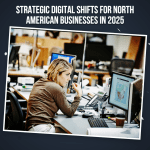Artificial intelligence is no longer a speculative advantage. In 2025, it is a foundational requirement for modern business operations. This report examines the essential AI software tools that small businesses must integrate to remain competitive, efficient, and scalable.
Drawing on extensive industry analysis, adoption data, and functional assessments, this toolkit provides a categorized evaluation of AI solutions with direct impact on operational performance.
I. Strategic Role of AI in Small Business
Small businesses today face increasing pressure to operate with the precision, reach, and adaptability of larger enterprises. AI solutions have emerged as the equalizer. From automating routine communications to managing large datasets and optimizing workflows, AI is reshaping how smaller organizations compete in digital and physical markets.
The current generation of AI tools enables decision-makers to reduce time waste, streamline internal processes, improve client engagement, and ultimately increase profitability. The objective is no longer simply to deploy AI, but to do so with clarity, control, and integration into daily operations.

II. Communication and Content Intelligence:
Effective communication remains a cornerstone of business operations. Whether through customer-facing channels or internal collaboration, the ability to produce clear, on-brand content at scale is mission-critical.
ChatGPT (OpenAI): As a foundational language model, ChatGPT is utilized by businesses for customer responses, drafting proposals, summarizing reports, and internal documentation. Its modularity allows teams to adapt outputs to multiple use cases, with minimal configuration. The interface is user-friendly, making it accessible for non-technical staff.
Jasper: This tool differentiates itself with brand-specific content generation. Jasper is particularly effective for companies maintaining consistent messaging across multiple platforms. Its ability to align tone, voice, and terminology ensures that marketing and public-facing materials reflect institutional standards.
Grammarly Business: More than a grammar checker, Grammarly Business acts as a real-time editor for professional writing. Its AI engine supports clarity, consistency, and tone control, particularly in customer service, legal, or formal documentation workflows. It also provides team-wide insights into writing trends and gaps.
Copy.ai: Ideal for high-velocity environments, Copy.ai automates the generation of product descriptions, social media posts, and email marketing content. Its SEO-awareness and A/B testing frameworks assist in refining engagement strategies with measurable returns.
III. Productivity and Workflow Systems:
AI-enhanced productivity tools are instrumental in managing tasks, personnel, and deliverables. These platforms do more than track, they analyze, adapt, and suggest optimizations in real-time.
Notion AI: A hybrid platform that merges documentation, collaboration, and task management into one cohesive system. Its AI features provide actionable insights, from drafting proposals to summarizing meeting notes. Small businesses benefit from Notion’s flexibility, especially when building custom workflows.
Motion: Motion applies algorithmic scheduling to individual and team calendars. It continuously reorganizes tasks based on shifting deadlines, availability, and priority. This minimizes idle time and optimizes focus hours across an organization.
Asana (AI-integrated)
Asana remains a project management leader, with AI-enhanced planning, automation, and tracking capabilities. It is particularly effective for cross-functional teams where clarity, visibility, and alignment are critical.
Trello (AI-assisted): With simple drag-and-drop visual boards, Trello integrates AI to offer smart card suggestions, due date optimizations, and workflow automation. It is often deployed in agile or creative environments where flexible project coordination is required.

IV. Data Analysis and Business Intelligence:
Data is only valuable when it can be understood and acted upon. AI-powered analytics tools enable businesses to extract insights from complex datasets without requiring in-house data scientists.
ThoughtSpot: A leader in search-based analytics, ThoughtSpot allows users to query databases using natural language. This dramatically lowers the barrier to business intelligence and supports real-time decision-making across departments.
Power BI and Tableau: Both platforms are standard in data visualization and predictive modeling. Their AI features include anomaly detection, trend forecasting, and dynamic dashboard generation. These tools are vital for businesses looking to integrate data-driven thinking into daily operations.
Glean: Positioned as a knowledge intelligence platform, Glean connects institutional documents, conversations, and employee knowledge to offer accurate, context-rich responses. It is particularly effective for onboarding, training, and customer support.
V. Meetings, Collaboration, and Client Interaction
As distributed work becomes the norm, businesses rely heavily on digital communication. AI tools in this category enhance clarity, structure, and retention across meetings and collaborative interactions.
Fireflies.ai: Automates meeting transcription, creates action item summaries, and integrates with major conferencing platforms. Fireflies increases post-meeting productivity and reduces the administrative burden on staff.
Krisp: Improves audio clarity by removing background noise, echo, and disturbances. This tool ensures high-quality audio in professional communications, especially for sales calls, webinars, and virtual support.
Buffer AI Assistant: Manages content scheduling and engagement for social media. It uses AI to recommend optimal posting times, adjust messaging tone, and provide performance metrics.
VI. Design and Media Generation:
In a visually driven marketplace, AI tools enable businesses to produce high-quality design and video content without the need for in-house creative departments.
Midjourney: Delivers AI-generated imagery from text prompts. It is particularly useful for marketing campaigns, product mockups, and digital branding.
Adobe Firefly: Integrates with Creative Cloud, providing generative fill, AI-driven editing, and rapid iteration tools. Firefly is enterprise-grade but accessible to small businesses via Adobe’s scalable plans.
Canva AI Tools: With simple drag-and-drop functionality, Canva’s AI suite supports automated design generation, brand kits, and instant resizing across platforms. It remains a popular solution for small businesses seeking affordable design output.
Descript: An end-to-end audio and video editing suite enhanced by AI. Key features include transcription, filler word removal, and voice cloning, allowing content teams to streamline editing processes without sacrificing quality.
VII. Technical Development and Custom Integration:
For businesses requiring custom applications or internal tools, AI solutions in development and API management are essential.
GitHub Copilot: Enhances developer productivity through real-time code suggestions, syntax correction, and function completion. Teams benefit from reduced error rates and faster delivery timelines.
OpenAI API: Provides direct access to foundational language models, allowing businesses to integrate advanced AI functions into their own software or customer interfaces.
Writer (Enterprise): Specialized for compliant, brand-safe content creation. Writer is deployed by organizations requiring strict regulatory adherence while scaling content production.
Elastic Search with AI Plugins: Combines full-text search with machine learning to surface relevant insights in structured and unstructured data. Useful for organizations building custom search solutions or dashboards.
Small businesses entering 2025 must think and act with the precision of much larger organizations. Artificial intelligence offers the infrastructure to do just that. This toolkit has outlined the core categories and leading tools across content, collaboration, productivity, analytics, and development.
Adoption alone, however, is not the goal. Businesses must integrate these tools into coherent workflows, align them with strategic objectives, and continuously evaluate performance. Those who succeed will not only reduce operational friction but also unlock new opportunities for growth, innovation, and market leadership.
As the business landscape continues to evolve, so too must the AI strategy underpinning it. The future belongs to organizations prepared to act intelligently today.







